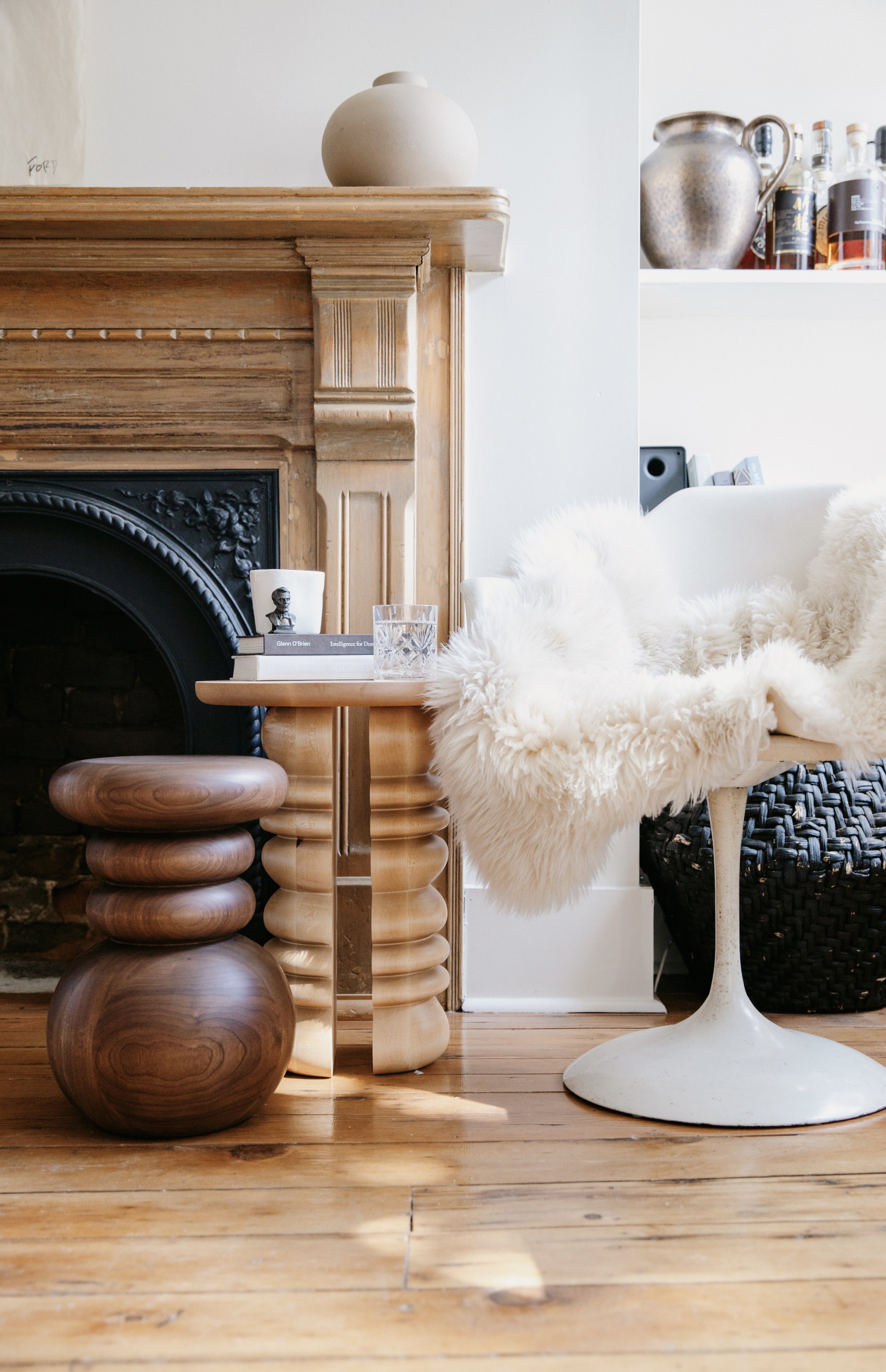Han Studio :
Where Art Meets Function in Handcrafted Furniture by Hanna Dausch
Hanna Dausch of Han Studio crafts a delicate balance between art and function, merging her background in sculpture and historic carpentry into a woodworking studio that redefines traditional boundaries. Her journey began with a passion for sculptural forms and ceramics, which evolved as she worked on historic homes in Chicago, finding inspiration in their architectural details and handcrafted furniture.
Today, Hanna’s Pittsburgh-based studio reflects her philosophy of ambiguity — pieces that exist between categories, where furniture meets art, and craft finds equal footing with expression. Hanna’s process is deeply intentional yet unrestrained by convention. Embracing imperfections and working spontaneously, she creates each piece with an intuitive approach, valuing the narrative embedded in handcrafted items.
In this feature, we explore the values driving Han Studio, the stories behind her made-to-order furniture and her insights on creativity, inviting us to see furniture as both an extension of home and a work of art.
Imagery & Styling by: Han Studio
Your woodworking journey has evolved from sculpture to furniture. Can you share more about how your time in Chicago and your work in historic preservation shaped your current approach to woodworking?
Originally, I went to school for sculpture with a focus on ceramics, but that soon changed to sculpture with a focus on woodworking. While studying woodworking, I stumbled upon the historic preservation department, enrolled in multiple classes and completed my required internship in historic preservation. This combination of woodworking and historic preservation snowballed, and suddenly all of my college work was about the relationship between wood and houses.
I graduated and was working as a historic carpenter in Chicago and became very influenced by the furniture in the houses I was working on. I also became interested in the conflict between art and craft. The definitions of “art,” “fine art,” “craftsmanship,” and “craft” are all so blurred, and to be honest, just silly. With my frustration over what was considered “art” and what was considered “craft,” I started making functional furniture pieces only.
Fast forward to the start of my business in October of 2019, I decided after strictly making sculptures and then strictly making furniture that I didn’t need to decide what something was going to be defined as. I could make work that walked the line of art and craft and the line of furniture and sculpture. The viewer can decide what they want it to be for their home. And I love that. I love the ambiguity of it, the idea that I can design a piece exactly how I want it to be without worrying about what it’s going to be defined as.
What led you to open your own woodworking studio in Pittsburgh, and how did this move impact your creative process?
To be completely honest, I had a few jobs that weren’t the right fit, and coming from a family of small business owners, I decided to take a shot at opening my own small business so that I could make the work I was actually passionate about. When I started my business in October 2019, I still kept two part-time jobs to support myself, but over the years, I made my woodworking business my full-time job.
I don’t think opening my woodworking studio impacted my creative process very much. Yes, there are custom projects you take on that you’re not passionate about but that are necessary to pay the bills (this happens in all businesses). But overall, I made sure to give myself the freedom to make what I want to make. In my experience, people are more interested in what you make because you’re excited about it, as opposed to making what other people want you to make.
In launching your new made-to-order furniture collection, what inspired the shift from smaller home decor items to larger, customizable pieces?
I always wanted to launch a collection of furniture, but I knew that starting a small business was tough enough to begin with — and starting a small business that only sells large pieces of furniture was even tougher. So, I started with smaller, more approachable pieces with the intent that over time I would slowly introduce larger and larger pieces. I will note that just because I now have a furniture collection does not mean that I will no longer make the smaller home decor pieces!
Can you describe your creative process when designing a new piece? How does the balance between functionality and artistry influence your work?
My creative process involves a lot of thinking and then overthinking. I draw a lot of inspiration from architecture and interior spaces, so typically I gather design ideas in my head and ruminate on them for weeks, months or sometimes even years. I almost have to convince myself that my idea is good enough to produce physically. Then once I’ve finally convinced myself, I immediately start making the piece.
I do very little sketching and prototyping, which any artisan would tell you is a terrible idea, but I am too excited to start making the actual piece. I definitely make mistakes, but this is a necessary part of the process for me — this is where I learn. And if I make too big of a mistake then I keep the piece for myself and make a new one (I don’t keep any of my “good” work, only the pieces I mess up haha).
The idea of “home” and its warmth play a significant role in your designs. How do you think handcrafted furniture adds to the emotional and aesthetic value of a home?
I feel if you want to know a person, you walk around their home. A home is such a special place. It is the place you can be yourself and always go back to. A home holds the pieces that describe you, that are important to you, that are valuable to you. Everything in a home is there because the person found it important enough at one time or another to bring it with them. All of the little marks — the scratches on the tables or pencil lines on the walls — hold memories, and those memories make up a person’s life.
Handcrafted furniture and decor are similar. They are made by hand and are a peek into the artisan themself. All of the colors and shapes and nooks and crannies are there because the artisan found them important enough in the design. They hold memories of what the artisan was experiencing at the time: a little bit of sadness, happiness, anger, etc., all mixed up into a final piece. And then one day this handcrafted piece is bought as a gift and brought into a new home. It brings with it warmth and becomes a part of that person’s life. They create memories with it and eventually pass it down to the next generation, where it will live on to become a part of that person’s life and so on.
So, in a roundabout way to answer your question, every piece holds stories and memories that make up a person’s life, and how wonderful it is to make something so important to a person that it can help describe them and tell the story of them when they’re gone.
Launching a business and a collection is a major milestone. What challenges have you faced along the way, and what has been your biggest triumph since starting Han Studio?
There have been many challenges along the way, and I can assure you that any person who owns a small business will tell you it’s not a walk in the park.
But I would say the biggest challenge I face is defending the value of my work. People constantly say your work isn’t good enough or it’s too expensive or it’s useless, and on and on. That is really hard to hear, especially after you put so much love and time into a piece. I feel I constantly need to prove to people that my work is good enough and worth the price.
But, I think my biggest triumph (which is still a work in progress) is my patience and kindness with myself. When I started my business I would push myself to go above and beyond constantly, even if it meant taking on more than I could handle, trying to sell to a person who would never buy or working on projects that I physically could not complete as one person. I learned over time that this was what would kill my business and that running myself into the ground every day was not sustainable. So I started teaching myself how to be patient and kind with myself. When I knew I was getting to my limit, I slowed down. When someone told me my work wasn’t worth it, instead of trying to convince them, I understood that they weren’t my customer and moved on. When I got sick, I didn’t push myself to work..
There is pressure as a small business, especially as a small business of one, to be “on” all the time, and the reality is that it’s just not possible. I’m only one person, and I can only do so much — so if I don’t look out for my needs first and foremost then I won’t have a business.
How do you envision the future of your woodworking practice and furniture collection? Are there any new materials or techniques you’re excited to explore?
I envision the future of my collection being bigger and more diverse. I would like to continue adding different pieces of furniture and home decor to my collection — chairs, tables, consoles, larger sculptures, couches, etc. I would also like to take the techniques I have been using on my smaller pieces and use them on a much larger scale — for example, taking my vase shapes and making them legs on a table. Or making my vases 10x the size they are now. I gather a lot of inspiration from ceramic techniques and am currently excited to be exploring ceramic glazing techniques. I am trying to figure out how to use these methods on wood instead. We’ll see how the pieces turn out (heehee no pun intended).
The theme for the 2024 edition of SOULBASE Magazine is “Creativity.” How do you define creativity, and how does it manifest in your work?
That’s a tough question. I feel there are many definitions of creativity, and creativity means something different to every person. But if I had to take a stab at it, I would say creativity is taking everything you experience in your surroundings, be that through sight, taste, sound, touch or smell, and organizing it in a way that satisfies you. I don’t think any idea is “original.” I think we take everything we experience and mumble jumble it in our heads to produce a different version of it that makes sense to us.
Where can we find your collection?
You can find my collection on my website at hanstudio.work/thecollection









